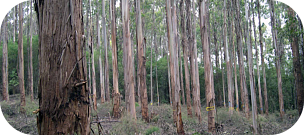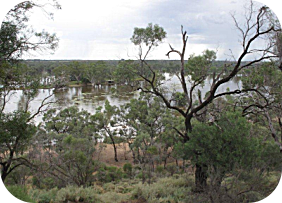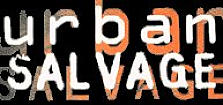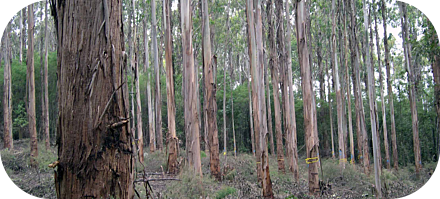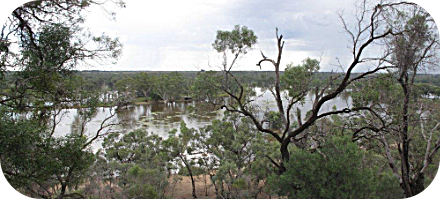Native Hardwood Timber
At
Urban
Salvage
we
believe
we
can
provide
genuine,
sensible
advice
to
customers
on
timber
and
avoid
exaggerated
claims
about
our
timber-
recycled
or
forest
product.
There
is
at
large
today
a
lot
of
hyperbole
about
timber
products
that
can
mislead
consumers.
Our
mission
is
-
Best
Use
of
Timber.
There
are
aspects
of
good
choice
such
as
design,
suitability,
durability
and
cost
-
as
well
as
provenance
-
that need to be considered in any purchase.
Plantation
softwoods,
steel
and
engineered
wood
structural
products
should
replace
native
hardwoods
in
the
specification
of
wall,
floor
and
roof
framing.
A
higher
value
for
native
hardwoods
would
mandate
this
trend.
Our
native
timber
is
a
special
type
of
commodity
that
we need to value well above common softwoods like slash pine.
New
technologies
such
as
radial
sawing
should
be
used
for
B-grade
log
that
is
currently
being
used
for
low-value
millings
or
is
woodchipped.
Production
values
in
sawmills
should
be
subject
to
accreditation
or
otherwise
valued
to
encourage
innovation
and
investment.
Maximising log yields and minimising waste should be recognised at the consumer end of timber manufacturing.
Woodchipping
contracts
in
native
forest
timber
create
too
many
pressures
on
the
resource.
Without
this
imperative,
the
sawlogging
industry
will
yield
a
smaller
supply
of
woodchip
as
a
by-product
of
milling
-
but
not
to
demand-determined
supply
contracts.
Industrial
volumes of woodchip are better supplied from plantation resource if real economies can be found in this trade.






Environmental Concerns


Native
hardwood
sales
should
carry
an
impost
that
deems
a
replacement
planting
of
native
sawlog
species
for
every
log
felled.
This
can
be
extended
to
cover
imported
log
or
sawn
board
-
else
the
problem
is
exported.
Of
ultimate
importance,
we
need
to
use
at
a
rate
equal
to
replacement
-
and
in
a
genuine
way.
Ironbark
for
Ironbark,
Blackbutt
for
Blackbutt.
Not
fast-growing
Blue
Gum
(E.
Globulus)
for our genuine eucalypt royalty in sawlog.
Investment
in
native
sawlog
plantation
requires
a
structured
approach
which
is
industry-specific,
because
the
cycle
of
growth
of
native
hardwoods
is
50
years
to
production.
Investment
in
hardwood
pulplog
plantations
has
only
a
12-15
year
growth
cycle.
Given
this
relativity, the market is unlikely to invest in sawlog plantations without planning and structure.


Ethical Choice in Timber Purchasing
In
recent
years,
purchasers
and
specifiers
of
native
hardwood
have
been
led
to
believe
they
can
specify
a
range
of
hardwoods
which
fall
into
the
category
of
ethically
good.
Certainly,
there
is
good
choice
and
bad
choice
in
timber
purchasing.
There
is
an
inherent
wisdom
in
most
good
decisions
we
make.
But
a
social
code
of
ethics
will
founder
in
the
complexity
of
practical
issues
in
craft
and
construction.
Timber
certification
is
a
necessary
step
in
our
progress
as
an
industry
and
a
consumer
nation,
but
needs
to
be
released
from
the
context
of
social
activism
and
identity
politics.
Certification
should
give
consumers
confidence
about
the
provenance
of
timber
products,
and
hardwood
sawmillers
should
be
valued
for
their
investment,
knowledge
and
skills,
and
many
more
brought
into
the
embrace of the certification process.

Appearance-Grade Timber from Plantation Hardwood
The
claim
that
plantation
product
broadly
exists
as
a
viable
alternative
to
other
managed
forest
hardwood
product
is
a
persistent
myth.
Most
plantation
hardwood
is
pulplog
-
suitable
only
for
paper
production.
With
specific
exceptions
(Western
District
Sugar
Gum
-
for
one),
plantation
hardwood
is
not
available
as
sawn
board
and
many
trees
that
reach
sawlog
age
do
not
satisfy
an
appearance-grade
market for hardwood.
There
is
a
similar
mythology
that
attaches
to
categories
like
rescued
log,
burnt
standing
timber,
diseased
trees,
fallen
trees
and
fire-
break
tree
removal
that
is
best
discounted
when
investigating
the
provenance
of
any
timber
product
you
might
purchase.
It
is
a
category
of
convenience-
sometimes
unlikely,
usually
unhelpful.
While
not
suggesting
you
don’t
buy
this
timber,
the
category
has
no
gravitas. There is no unique merit in the purchase. It is just a harmless opportunity that need not be shouted about in media.
The
current
native
forest
argument,
broadly
speaking,
is
not
really
an
ethical
one.
It's
a
practical
issue
of
history,
tradition
and
change
that
should
employ
a
conventional
wisdom
in
its
resolution.
We
need
to
set
aside
unique
areas
from
access
to
logging.
The
Tarkine
Wilderness,
Wilson’s
Promontory,
tropical
rainforests,
and
iconic
areas
in
other
states.
Why?
Because
they
have
a
higher
value
-
in
a
broad sense - as standing forests and woodlands than they would as timber.


Consider
this.
Nothing
is
perfect.
Nothing
can
return
our
continent
to
the
pristine
state
that
we
believe
existed
before
man
arrived.
Can
we
then
try
to
live
in
the
least-worst
world
rather
than
thinking
in
polarities
such
as
Good
and
Evil
applied
to
commodities
like
timber.
Recycled
timber
options
also
have
to
be
assessed
in
terms
of
practical
wisdom
-
rather
than
forgiven
all
costs.
Recycled
timber
products
can
involve
expensive
processing
and
many
diesel
miles
if
trucked
in
from
other
regions.
Regional
supply
is
often
overlooked
and not always promoted as a good choice by the same media that applauds certified and recycled timber choice.

© Urban Salvage
Website by VP-IT
190A Hall Street
SPOTSWOOD
Victoria 3015

03 9391 0466
03 9391 0466
Native Hardwood Timber
At
Urban
Salvage
we
believe
we
can
provide
genuine,
sensible
advice
to
customers
on
timber
and
avoid
exaggerated
claims
about
our
timber-
recycled
or
forest
product.
There
is
at
large
today
a
lot
of
hyperbole
about
timber
products
that
can
mislead
consumers.
Our
mission
is
-
Best
Use
of
Timber.
There
are
aspects
of
good
choice
such
as
design,
suitability,
durability
and
cost
-
as
well
as
provenance
-
that
need
to
be
considered
in
any
purchase.
Plantation
softwoods,
steel
and
engineered
wood
structural
products
should
replace
native
hardwoods
in
the
specification
of
wall,
floor
and
roof
framing.
A
higher
value
for
native
hardwoods
would
mandate
this
trend.
Our
native
timber
is
a
special
type
of
commodity
that
we
need
to
value
well
above
common
softwoods like slash pine.
New
technologies
such
as
radial
sawing
should
be
used
for
B-grade
log
that
is
currently
being
used for low-value millings or is woodchipped.
Production
values
in
sawmills
should
be
subject
to
accreditation
or
otherwise
valued
to
encourage
innovation
and
investment.
Maximising
log
yields
and
minimising
waste
should
be
recognised
at
the
consumer
end
of
timber manufacturing.
Woodchipping
contracts
in
native
forest
timber
create
too
many
pressures
on
the
resource.
Without
this
imperative,
the
sawlogging
industry
will
yield
a
smaller
supply
of
woodchip
as
a
by-product
of
milling
-
but
not
to
demand-
determined
supply
contracts.
Industrial
volumes
of
woodchip
are
better
supplied
from
plantation
resource
if
real
economies
can
be
found in this trade.






Environmental Concerns


Native
hardwood
sales
should
carry
an
impost
that
deems
a
replacement
planting
of
native
sawlog
species
for
every
log
felled.
This
can
be
extended
to
cover
imported
log
or
sawn
board
-
else
the
problem
is
exported.
Of
ultimate
importance,
we
need
to
use
at
a
rate
equal
to
replacement
-
and
in
a
genuine
way.
Ironbark
for
Ironbark,
Blackbutt
for
Blackbutt.
Not
fast-
growing
Blue
Gum
(E.
Globulus)
for
our
genuine
eucalypt royalty in sawlog.
Investment
in
native
sawlog
plantation
requires
a
structured
approach
which
is
industry-
specific,
because
the
cycle
of
growth
of
native
hardwoods
is
50
years
to
production.
Investment
in
hardwood
pulplog
plantations
has
only
a
12-15
year
growth
cycle.
Given
this
relativity,
the
market
is
unlikely
to
invest
in
sawlog
plantations
without
planning
and
structure.


Ethical Choice in Timber Purchasing
In
recent
years,
purchasers
and
specifiers
of
native
hardwood
have
been
led
to
believe
they
can
specify
a
range
of
hardwoods
which
fall
into
the
category
of
ethically
good.
Certainly,
there
is
good
choice
and
bad
choice
in
timber
purchasing.
There
is
an
inherent
wisdom
in
most
good
decisions
we
make.
But
a
social
code
of
ethics
will
founder
in
the
complexity
of
practical
issues
in
craft
and
construction.
Timber
certification
is
a
necessary
step
in
our
progress
as
an
industry
and
a
consumer
nation,
but
needs
to
be
released
from
the
context
of
social
activism
and
identity
politics.
Certification
should
give
consumers
confidence
about
the
provenance
of
timber
products,
and
hardwood
sawmillers
should
be
valued
for
their
investment,
knowledge
and
skills,
and
many
more
brought
into
the
embrace
of
the
certification process.

Appearance-Grade Timber from Plantation
Hardwood
The
claim
that
plantation
product
broadly
exists
as
a
viable
alternative
to
other
managed
forest
hardwood
product
is
a
persistent
myth.
Most
plantation
hardwood
is
pulplog
-
suitable
only
for
paper
production.
With
specific
exceptions
(Western
District
Sugar
Gum
-
for
one),
plantation
hardwood
is
not
available
as
sawn
board
and
many
trees
that
reach
sawlog
age
do
not
satisfy
an
appearance-grade
market
for
hardwood.
There
is
a
similar
mythology
that
attaches
to
categories
like
rescued
log,
burnt
standing
timber,
diseased
trees,
fallen
trees
and
fire-
break
tree
removal
that
is
best
discounted
when
investigating
the
provenance
of
any
timber
product
you
might
purchase.
It
is
a
category
of
convenience-
sometimes
unlikely,
usually
unhelpful.
While
not
suggesting
you
don’t
buy
this
timber,
the
category
has
no
gravitas.
There
is
no
unique
merit
in
the
purchase.
It
is
just
a
harmless
opportunity
that
need not be shouted about in media.
The
current
native
forest
argument,
broadly
speaking,
is
not
really
an
ethical
one.
It's
a
practical
issue
of
history,
tradition
and
change
that
should
employ
a
conventional
wisdom
in
its
resolution.
We
need
to
set
aside
unique
areas
from
access
to
logging.
The
Tarkine
Wilderness,
Wilson’s
Promontory,
tropical
rainforests,
and
iconic
areas
in
other
states.
Why?
Because
they
have
a
higher
value
-
in
a
broad
sense
-
as
standing
forests
and
woodlands than they would as timber.


Consider
this.
Nothing
is
perfect.
Nothing
can
return
our
continent
to
the
pristine
state
that
we
believe
existed
before
man
arrived.
Can
we
then
try
to
live
in
the
least-worst
world
rather
than
thinking
in
polarities
such
as
Good
and
Evil
applied
to
commodities
like
timber.
Recycled
timber
options
also
have
to
be
assessed
in
terms
of
practical
wisdom
-
rather
than
forgiven
all
costs.
Recycled
timber
products
can
involve
expensive
processing
and
many
diesel
miles
if
trucked
in
from
other
regions.
Regional
supply
is
often
overlooked
and
not
always
promoted
as
a
good
choice
by
the
same
media
that
applauds certified and recycled timber choice.

© Urban Salvage
Website by VP-IT
190A Hall Street
SPOTSWOOD
Victoria 3015

03 9391 0466
03 9391 0466
MENU
